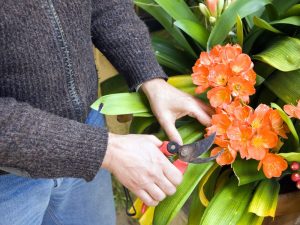Last Updated on August 8, 2024 by teamobn
These days, many homeowners grow certain varieties of amaranth strictly as a front lawn ornamental plant. If you are unfamiliar with this close cousin of the quinoa, then that should give you an idea as to its striking appearance.
In fact, growing amaranth was a staple in the kitchen gardens of the Aztecs. The plant enjoyed a moment of culinary popularity in the US in the 1970s when non-government organizations introduced it to homesteaders as an edible grain.
The plant became an ornamental garden fixture only after Americans abandoned their kitchen gardens for the supermarket produce section.
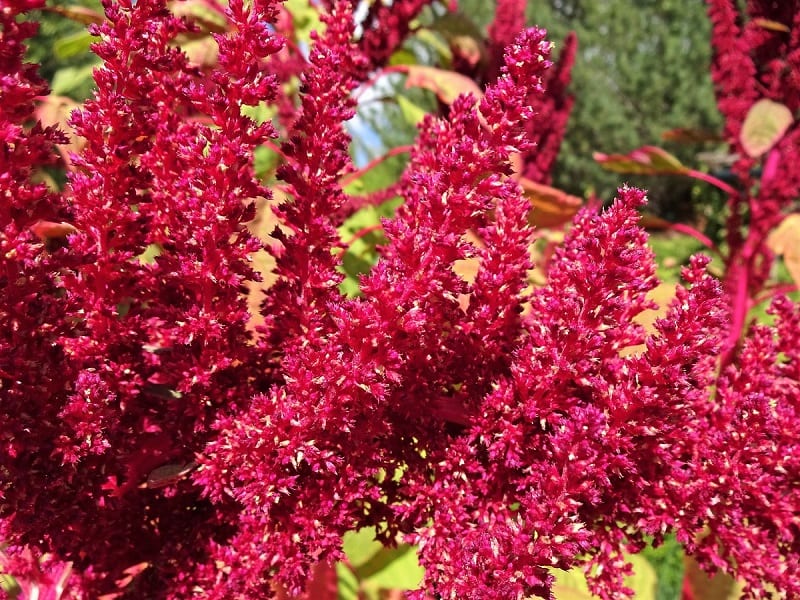
Growing Amaranth for Greens
Contents
In many parts of the world, however, growing amaranth is still primarily considered a grain crop because of its small, nutty-flavored seeds. But the plant’s productive potential extends beyond grains. This ancient herb is covered in nutritious foliage with a flavor similar to spinach.
Here is how to grow amaranth for greens in your backyard – or front lawn, for that matter.
Selecting the Right Seeds and the Right Time
Purchase seeds of a variety of amaranth bred specifically for greens production. These include Green Calaloo, with its lush, verdant foliage; and Burgundy, which produces gorgeous red shoots. You can grow Red Leaf Stripe for its red and green multicolored foliage; or Tricolor with red, burgundy, and green foliage.
Unlike other leafy green vegetables, amaranth flourishes in hot weather. The vegetable’s tiny seeds germinate best at soil temperatures of around 20°C, and so it is best to wait until mid-to-late spring to plant. The crop is also intolerant of frosts, so make sure to head out only after the danger of frost has passed before growing amaranth.
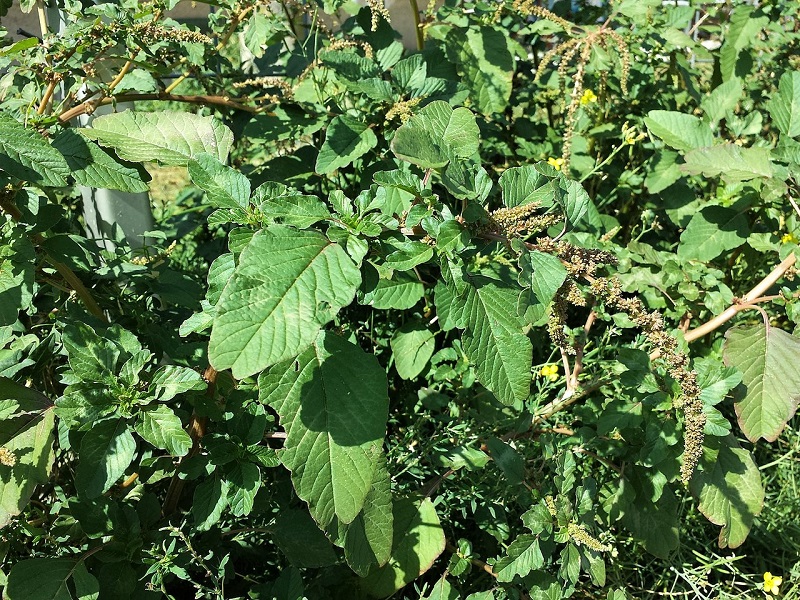
(Photo: Stefan lefnaer/Wikimedia Commons)
Preparing the Site
Select a site that receives a minimum of six to eight hours of full sun a day. Being a native of Mexico and Central America, amaranth is drought-tolerant. But your crop will do better when planted in moist, well-draining soil.
Because you will be growing amaranth for its foliage, you will need more nitrogen in the soil than you would when growing it for grain. Enrich the soil with compost or aged manure. If you are so inclined, or if the condition of the soil warrants, you can also add a few small handfuls of bloodmeal or cottonseed meal to the planting area.
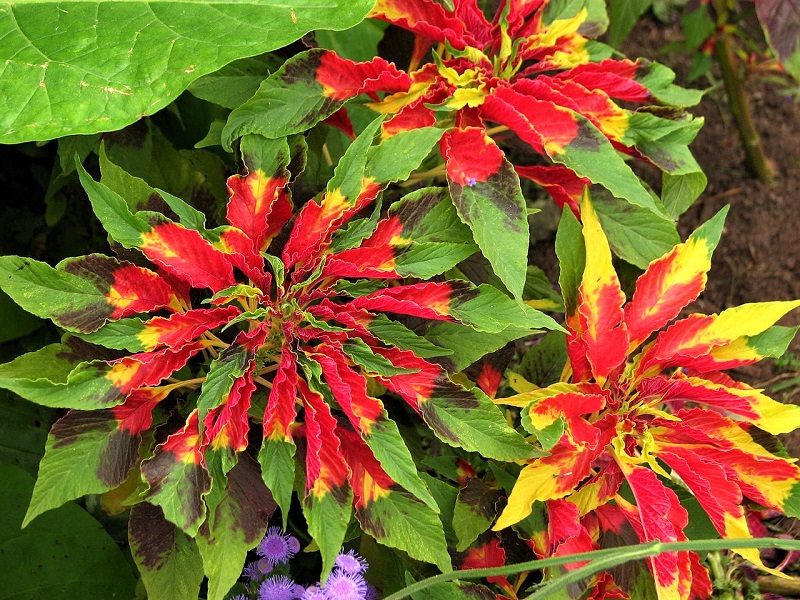
Growing Amaranth from Seed
The seeds of the amaranth are extremely small. Mix them with coarse-grained sand to ensure even distribution on the planting bed. Distribute the seeds sparingly across the surface of a finely tilled planting bed, then gently rake them in. You do not need to bother with rows or trenches. You will be harvesting the greens well before the plants reach maturity.
Water the planting bed evenly. Continue watering the plot every day, supplying the seeds with about an inch of water each week. The amaranth is robust and easygoing and will require little else in the way of maintenance and care. The seeds will sprout in seven to 14 days.
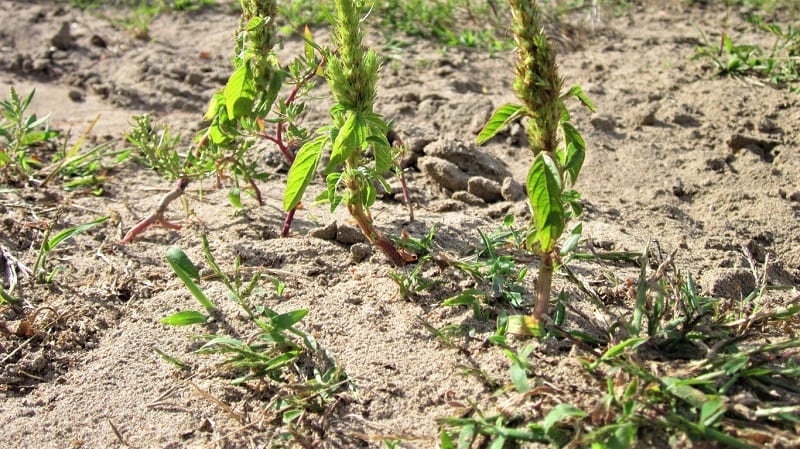
Harvesting Amaranth Greens
Regardless of the cultivar, you can harvest amaranth leaves at any point during the course of the plant’s growth. You can even harvest the tiny sprouts with their first pair of true leaves as micro-greens. The young shoots are deliciously tender. For greater production, however, allow the plants to reach 1 to 2 feet tall before harvesting.
To harvest young amaranth greens, cut off the entire plant a few inches above ground level. Often the plant will re-sprout and produce a second – and even third – crop of greens. Using this method, you can enjoy fresh amaranth greens all summer. If the plants grow faster than you can use the shoots, allow some to grow and flower.
Mature amaranth plants produce spectacular minarets of flowers. Depending on the variety, the plants can grow 5 to 6 feet tall. Allow a few plants to flower every year. They will drop seed and your amaranth crop will continue the following season.
Pest and Disease Management
While growing amaranth in your yard offers a healthy harvest, like any plant it might be vulnerable to particular pests and diseases. Good management guarantees a plentiful crop and a normal cycle of development. This will help you to safeguard your amaranth plants all through their development.
Common Pests Affecting Amaranth
Amaranth can draw many kinds of pests. Particularly fond to amaranth, aphids and flea beetles can cause major damage by eating on leaves and stems. While flea beetles cause tiny holes in the leaves, aphids, small sap-sucking insects usually gather on their undersides. Ladybugs or lacewings, which feed on aphids, might help your garden organically control these pests. For flea beetles, diatomaceous earth dispersed around plant bases can discourage them rather successfully.
Diseases to Watch For
Though not immune to illnesses, amaranth is strong. Common problems include fungal infections, which flourish in wet environments and include downy mildew and powdery mildew. Whereas downy mildew typically begins as yellow dots that turn purple, powdery mildew shows as white, powdery specks on leaves and stems.
Make sure your amaranth has sufficient air circulation and steer clear of overhead watering to keep the foliage dry in order to prevent these Should infection take place, organic fungicides such as neem oil can be applied to afflicted areas.
Preventative Care
Preventative care is crucial when growing amaranth. Rotate your crops annually to prevent soil-borne diseases and reduce pest buildup. Amaranth thrives in well-draining soil, so improving your garden’s drainage can help prevent root rot diseases. Additionally, regularly inspecting your plants allows you to catch and address issues before they escalate.
Natural Remedies and Treatments
Choosing natural solutions to combat pests and diseases when growing amaranth will help your plants as well as the surroundings. Because neem oil functions as both a fungicide and a pesticide without damaging beneficial insects, it is a great all-around choice. Using bacillus thuringiensis (BT) can be a successful biological therapy for some pests like caterpillars, which can periodically target amaranth.
Maintaining a Healthy Amaranth Crop
The secret to good amaranth farming is ultimately constant attention and care. Understanding the particular requirements and difficulties of cultivating amaranth can help gardeners to appreciate both its nutritional worth and ornamental attractiveness. Regularly looking for indicators of stress, including discoloration or slowed development, will enable you to act quickly and preserve the condition of your amaranth plants.
Using these techniques will help you control any pests and illnesses that can develop, therefore guaranteeing that your amaranth stays a brilliant and useful component of your garden.
Amaranth as a Companion Plant
Growing amaranth not only provides a nutritious crop but also offers several benefits when used as a companion plant in your garden. Amaranth’s tall and leafy stature can enhance the growth and health of other plants by providing shade, attracting beneficial insects, and improving soil health. Here’s how incorporating amaranth can benefit your gardening efforts.
Attracting Beneficial Insects
Amaranth flowers are prolific producers of nectar and pollen, attracting a wide variety of beneficial insects. These include pollinators like bees and butterflies, which are essential for the pollination of many garden crops. Additionally, growing amaranth can attract predatory insects such as ladybugs and lacewings, which help control pest populations naturally. This reduces the need for chemical insecticides, promoting a healthier garden environment.
Providing Shade and Temperature Control
Amaranth’s height and dense foliage make it a great choice for shielding plants that need cover from strong noon sun. Growing amaranth may greatly reduce the temperature surrounding more fragile herbs or vegetables like lettuce, which often bolts in extreme heat, therefore extending their growing season and increasing production.
Soil Improvement and Moisture Retention
One natural approach to improve the soil structure and moisture retention capacity in your garden is growing amaranths. Amaranth’s large root system aerates the ground and strengthens it by penetrating far down.
In sandy soils, which usually drain water fast and have poor nutrient retention, this is very helpful. For surrounding plants with maybe less extensive root systems, Amaranth’s roots help keep water near the surface.
These roots can stabilize the ground, so preventing soil erosion; they can break up compacted areas, so increasing the availability of vital nutrients to nearby plants. Including amaranth into your garden helps to improve the general fertility and health of the soil, therefore supporting the development and vigor of surrounding plants.
Suppressing Weeds
Amaranth’s fast expansion and broad cover created by its leaves help it to control weeds. Amaranth creates a thick shadow over the ground as it develops, therefore limiting the light accessible for weed seed germination. In organic gardens, where the use of chemical pesticides is limited or avoided completely, this natural form of weed management is especially useful.
For the amaranth and its allies, the shadowing also helps preserve soil moisture, which is good; yet, it stunts weed development. Growing amaranth so not only improves the health and output of your garden but also greatly lessens the work required in weed control. This makes amaranth a great option for gardeners trying to maximize the health and output of their plants while cutting care.
Enhancing Garden Aesthetics
Apart from its functional use, growing amaranth greatly improves the appearance of every garden. Amaranth can be the center point or a lovely background in garden design with its vivid hues ranging from deep reds to radiant golds and its arresting construction. While the vivid hues of its flowering spikes grab the eye and give the garden’s color palette depth, its tall, elegant stalks and broad leaves provide garden areas a rich, verdant impression.
Growing amaranth among lower-growing plants not only increases the usefulness of the garden but also enhances its visual attractiveness, therefore turning an ordinary garden into a lovely scene. Amaranth may generate dynamic visual layers in the garden, therefore transforming it from a place of production to a haven of beauty and leisure.
Growing amaranth as a companion plant will help your garden to be much more varied, productive, and lovely. This method not only makes best use of space but also advances a more sustainable and healthy gardening technique.
Conclusion
Growing amaranth offers a multitude of benefits, ranging from soil health improvement to natural weed suppression and aesthetic enhancement of garden spaces. Its versatility and ease of cultivation make it a valuable addition to any garden, contributing to a sustainable and productive ecosystem. Embracing amaranth in your gardening practices can lead to a healthier, more vibrant, and visually appealing outdoor space.
Add more variety to your garden and kitchen table with our guide on how to grow broccoli at home!




